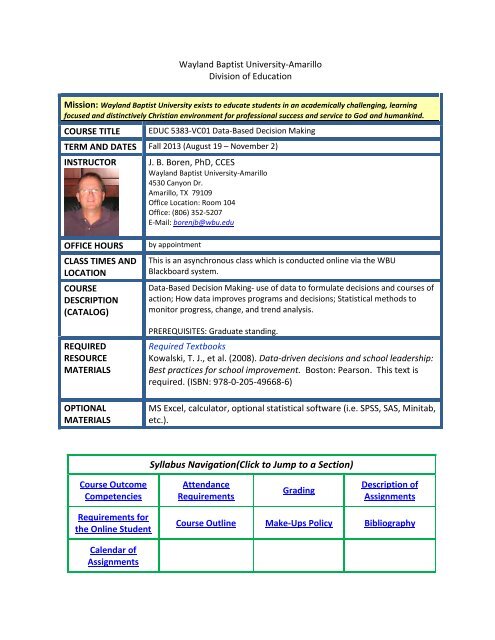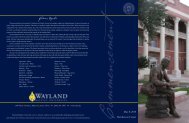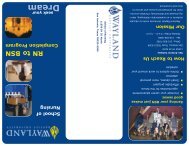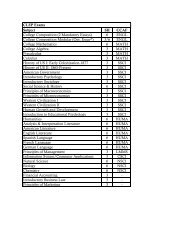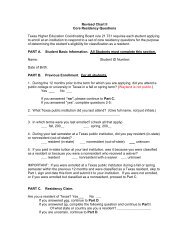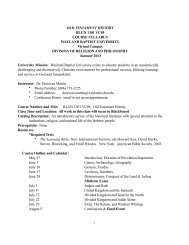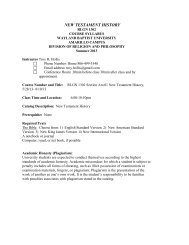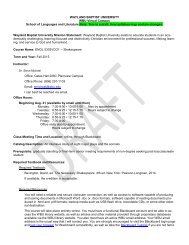Data-Based Decision Making - Wayland Baptist University
Data-Based Decision Making - Wayland Baptist University
Data-Based Decision Making - Wayland Baptist University
- No tags were found...
You also want an ePaper? Increase the reach of your titles
YUMPU automatically turns print PDFs into web optimized ePapers that Google loves.
<strong>Wayland</strong> <strong>Baptist</strong> <strong>University</strong>-AmarilloDivision of EducationMission: <strong>Wayland</strong> <strong>Baptist</strong> <strong>University</strong> exists to educate students in an academically challenging, learningfocused and distinctively Christian environment for professional success and service to God and humankind.COURSE TITLEEDUC 5383-VC01 <strong>Data</strong>-<strong>Based</strong> <strong>Decision</strong> <strong>Making</strong>TERM AND DATES Fall 2013 (August 19 – November 2)INSTRUCTORJ. B. Boren, PhD, CCES<strong>Wayland</strong> <strong>Baptist</strong> <strong>University</strong>-Amarillo4530 Canyon Dr.Amarillo, TX 79109Office Location: Room 104Office: (806) 352-5207E-Mail: borenjb@wbu.eduOFFICE HOURSCLASS TIMES ANDLOCATIONCOURSEDESCRIPTION(CATALOG)REQUIREDRESOURCEMATERIALSOPTIONALMATERIALSby appointmentThis is an asynchronous class which is conducted online via the WBUBlackboard system.<strong>Data</strong>-<strong>Based</strong> <strong>Decision</strong> <strong>Making</strong>- use of data to formulate decisions and courses ofaction; How data improves programs and decisions; Statistical methods tomonitor progress, change, and trend analysis.PREREQUISITES: Graduate standing.Required TextbooksKowalski, T. J., et al. (2008). <strong>Data</strong>-driven decisions and school leadership:Best practices for school improvement. Boston: Pearson. This text isrequired. (ISBN: 978-0-205-49668-6)MS Excel, calculator, optional statistical software (i.e. SPSS, SAS, Minitab,etc.).Syllabus Navigation(Click to Jump to a Section)Course OutcomeCompetenciesAttendanceRequirementsGradingDescription ofAssignmentsRequirements forthe Online StudentCourse Outline Make-Ups Policy BibliographyCalendar ofAssignments
Course Outcome Competencies:The student will demonstrate a knowledge of statistical inquiry by analyzing sample assessments andcomparing the results with the standard or goal being investigated.The student will demonstrate professional presentation skills by preparing documents or presentationsoutlining the findings the analysis.The student will perform appropriate statistical procedures to the data sets provided.Attendance Requirements: (Online Class)Students are expected to participate in all required instructional activities in their courses. Online courses are nodifferent in this regard; however, participation must be defined in a different manner.1. Student “attendance” in an online course is defined as active participation in the course as described inthe course syllabus. Instructors in online courses are responsible for providing students with clearinstructions for how they are required to participate in the course. Additionally, instructors areresponsible for incorporating specific instructional activities within their course and will, at a minimum,have weekly mechanisms for documenting student participation. These mechanisms may include, butare not limited to, participating in a weekly discussion board, submitting/completing assignments inBlackboard, or communicating with the instructor.2. Students aware of necessary absences must inform the professor with as much advance notice aspossible in order to make appropriate arrangements.3. Any student absent 25 percent or more of the online course, i.e., non-participatory during 3 or moreweeks of an 11 week term, may receive an F for that course. Instructors may also file a Report ofUnsatisfactory Progress for students with excessive non-participation.4. Any student who has not actively participated in an online class prior to the census date for any giventerm is considered a "no-show" and will be administratively withdrawn from the class without record.To be counted as actively participating, it is not sufficient to log in and view the course. The studentmust be submitting work as described in the course syllabus.Additional attendance and participation policies for each course, as defined by the instructor in the coursesyllabus, are considered a part of the university’s attendance policy.Disability Statement: Any student, who because of a disabling condition, may require some specialarrangement in order to meet course requirements, should contact the instructor on the first day of class tomake the necessary accommodations. In compliance with the Americans with Disabilities Act of 1990 (ADA), it isthe policy of <strong>Wayland</strong> <strong>Baptist</strong> <strong>University</strong> that no otherwise qualified person with a disability be excluded fromparticipation in, be denied the benefits of, or be subject to discrimination under any educational program oractivity in the university. The coordinator of Counseling Services serves as the coordinator of students with adisability and should be contacted concerning accommodation requests at (806) 291-3765. Documentation of adisability must accompany any request for accommodations.Course Requirements and Grading CriteriaBecause it is so important for teachers and administrators to effectively communicate ideas to colleagues,parents, and administrators, writing clear and error-free English is a priority at the <strong>Wayland</strong> <strong>Baptist</strong> <strong>University</strong>School of Education. Therefore, your ability to express your knowledge of educational concepts and theories withclear and accurate writing will be assessed through your assignments. The evaluation will be based on bothcontent and mechanics.
Grading Policy and ScaleDiscussion BoardReading ResearchSupport PaperAnalysis of Local PracticesFinal ExamTotal200 pts.200 pts.200 pts.300 pts.100 pts.1000 pts.A 900 and aboveB 800-899C 700-799D 600-699F 599 and belowA grade of incomplete is changed if the deficiency is made up by the middle of the next regular semester,otherwise it becomes an “F.” This grade is given only if circumstances beyond the student’s control preventedcompletion of work during the semester enrolled and attendance requirements have been met, and then only inthe last two weeks of a class. For a student to be granted an “I” the instructor must file an incomplete reportwhich details which work must be completed by the student and the deadline date for the completion. Theincomplete report must be signed by the instructor and the student (exception for VC students in remote areas).Description of AssignmentsDiscussion Board- There are several DB assignments in this course. See the DB schedule at the end ofthe syllabus for details on each assignment and due dates. Write your discussion board entries with thesame care you would write a hard-copy to turn in for a grade. Do not use emoticons or other‘chatroom’ slang…these will receive deductions in points. All of your writing in this course should begraduate-level and professional. The DB segment is worth 20% of the course grade.When responding to classmates’ work, one or two sentences per question is not enough. You arerequired to respond to other students in a substantive way. Saying, ‘I agree’ is NOT a substantivecomment. If you agree, say why. If you don’t agree, use reasoned arguments, not emotion, as arebuttal. If you use the words, ‘I feel’ in your paper or your responses, you are probably arguing fromemotion, not from reason. Saying ‘I feel’ on a discussion board is a wide-open invitation for yourinstructor to jump all over your comments and start searching your personal belongings without awarrant (in a figurative way).Reading Research- Each student will be assigned several related research papers to read. These will besummarized on Blackboard. Students will select articles of interest to them from the professionalliterature. These articles are to be from peer-reviewed scholarly journals…no Wikipedia or encyclopediajunk. This will comprise 20% of the course grade.Project- The class project is divided into two related parts: the Power Point presentation and theSupport Paper. The presentation will be an analysis of local practices (see below for details); it will beconstructed in Microsoft Power Point as a professional presentation. The Support Paper will be thesupporting narrative for the presentation. Together, these two pieces will comprise 50% of the coursegrade.Analysis of Local Practices- Each student will do an analysis of a local (your employer or area ofresponsibility) practices in data-based decision making. This analysis should be prepared forpresentation by incorporating it into a professionally-done Microsoft Power Point presentation. Thispresentation should equate in length to a ten- to fifteen-minute presentation. (Since this is anonline class, you will not be presenting it to the class, but will be posting it to Blackboard.) Thisproject will also include work on the Discussion Board to solicit input from classmates. The project isworth 30% of the course grade.
Support Paper- Each student will write a paper which is the supporting narrative, data, andresources you used to complete your Power Point project. This paper is to be the foundation for aprofessional presentation using the Power Point (above). This presentation may be prepared foruse in your local organization (i.e. a workshop or meeting) or for a broader audience (i.e. aconference). The goal of the projectd is to have the student use data to make decisions and drawconclusions about a topic of interest, then compile this information in a presentable format for theuses described above. These parts of the class should integrate into one whole when you arefinished. This paper is worth 20% of the course grade. Final Exam- The final exam is a comprehensive exam covering the entire term. This exam is worth 10%of the course grade. BONUS: If you turn in all assignments on time, and meet each deadline for thisclass, you may waive (skip) the final exam. If you choose this option, your final grade will be determinedby dividing your total accumulated points by 900 instead of by 1000.IMPORTANT! All submitted work, whether in Blackboard or via email, must be in one of the followingformats: .doc, .docx, .txt, or PDF.Note on the Use of APA Style: School of Education policy requires the use of the APA style manual forall papers. This style manual should have been taught in previous (undergraduate) coursework;however, if you were not instructed in the proper use of APA style, you are responsible for learning it forthis course. Either get an APA style manual (most college bookstores have them, as well as amazon.com,etc.), or get online and google ‘APA style’ and look at some of the free resources you find there. I willdeduct points from all assignments which require APA style but are not written as such. (This wouldinclude primarily your project in this course.)Specific Requirements for the Online Student-Compatible Computer and Access to Blackboard- You CANNOT take this course unless you can do thefollowingoHave regular access to a computero Be able to log in to Blackboard, navigate, and find and complete your assignmentso Be able to rectify any software issues related to using Blackboardo Be able to communicate with the instructor via emailo Know how to check to see if assignments have posted to BlackboardIf you cannot do ALL of the above, for the duration of the course, you must do one of the following-Borrow a friend’s computer, Find a public computer, or drop the course**Computer incompatability, inability to understand how to use Blackboard, orsoftware issues are NOT excuses for non-completion of assignments!! **Lack of access to a textbook is not an excuse for failing to complete the assignments in the class. If you cannotfind a textbook, get in touch with your advisor or the WBU bookstore immediately. If you cannot afford thetextbook, you should drop the class and retake it once you have saved enough money to buy the book.I understand getting a book in time for the first week’s assignments may be difficult. In the past, I did not makeany work due during the first week, but the new federal attendance guidelines for online programs has made itnecessary to track weekly attendance by participation, and this includes the first week. As a matter of policy, allcourses must now have weekly assignments due, so we will have assignments due the first week. If you get in a
Make-ups Policy- Since this course is asynchronous (not minute-by-minute live contact), and the units are openfor significant amounts of time, there will be NO make-ups allowed. If your work schedule has you away fromthe internet for more than two weeks, contact me beforehand and we’ll work something out. This isn’t simplehard-headedness on my part; once an assignment times out (closes) on Blackboard, it cannot be re-opened for asingle student. It is all or nothing. So please don’t miss assignments, and if you do, please don’t ask for makeups.
BibliographyAmerican Educational Research Association (2004). Encyclopedia of educational research, 7 th ed. New York:Macmillan.American Psychological Association (2010). Publication manual of the American Psychological Association, 6 th ed.Washington, DC: APA.Berry, W. D. (1993). Understanding regression assumptions. Sage Series on Quantitative Applications in theSocial Sciences, vol. 92. Newbury Park: Sage Publications.Blake, R. M., Ducasse, C. J., Madden, E. H. (1960). Theories of scientific method: Renaissance through thenineteenth century. Seattle: Univ. of Washington Press.Campbell, D. T. & Stanley, J. C. (1963). Experimental and quasi-experimental designs for research. Chicago: RandMcNally.Clagett, M. (1969). Critical problems in the history of science. Madison, WI: Univ. of Wisconsin Press.Cohen, J. (1988). Statistical power analysis for the behavioral sciences. Hillsdale, NJ: Erlbaum.Collyer, C. E., & Enns, J. T. (1987). Analysis of variance: The basic designs.Conover, W. J. (1999). Practical non-parametric statistics, 3 rd ed. New York: John Wiley & Sons, Inc.Coolidge, F. L. (2013). Statistics: A gentle introduction, 3 rd ed. Thousand Oaks, CA: Sage.Cresswell, J. (2005). Educational research: planning, conducting, and evaluating quantitative and qualitativeresearch, 2nd ed. Pearson: Upper Saddle River, NJ.Cresswell, J. (2008). Research design: Qualitative, quantitative, and mixed methods research. Thousand Oaks, CA:Sage.Cronbach, L. J. (1951). Coefficient alpha and the internal structure of tests. Psychometrika, 16, 297-334.Cunningham, J. B. & Aldrich, J. O. (2012). Using SPSS: An interactive hands-on approach. Thousand Oaks, CA:Sage.Feldt, L. S. & Brennan, R. L. (1989). Reliability. In R. Brennan (ed.), Educational measurement. New York: Amer.Counc. on Educ. and Meas.Field, A. (2013). Discovering statistics using IBM SPSS statistics, 4 th ed. Thousand Oaks, CA: Sage.Frankel, J.R., Wallen, N.E., and Hyun, H.H. (2012). How to design and evaluate research in education, 8 th ed. NewYork, NY: McGraw-Hill.Freund, R. J., & Wilson, W. J. (1993). Statistical methods. Boston: Academic Press, Inc.Gay, L.R., et al. (2006). Educational research: Competencies for analysis and applications. Columbus, OH: MerrillPrentice Hall.Hedges, L. V. (1998). Statistical methods for meta-analysis. San Diego: Academic Press.
Holcomb, Z. C. (2007). Interpreting basic statistics, 5th ed. Pyrczak Publishing: Glendale, CA.Iman, Ronald L. (1994). A data-based approach to statistics.Johnson, R. B. & Onwuegbuzie, A. J. (2004). Mixed methods research: A paradigm whose time has come.Educational Researcher, 33(7), 14-26.Kirk, R. E. (1994). Experimental design: Procedures for the behavioral sciences, 3rd ed. Pacific Grove, CA:Brooks/Cole.Kleinbaum, D. G., Kupper, L. L., & Miller, K. E. (1988). Applied regression analysis and other multivariablemethods, 2nd ed. Boston: PWS - Kent Publ. Co.Kuder, G. F. & Richardson, M. W. (1937). The theory of estimation of test reliability. Psychometrika, 2, 151-160.Lauer, P. A. (2006). An education research primer. San Francisco: Jossey-Bass.Lentner, M., & Bishop, T. (1993). Experimental design and analysis, 2nd ed. Blacksburg, VA: Valley Book Co.Likert, R. (1932). A technique for the measurement of attitudes. Archives of Psychology, no. 140.Lipsey, M. W. & Wilson, D. B. (2000). Practical meta-analysis. Thousand Oaks, CA: Sage.Lodico , M. G., Spaulding , D. T., & Voegtle , K. H. (2006). Methods in Educational Research: From Theory toPractice . Jossey-Bass.Moreland, J. P. (1989). Christianity and the nature of science: a philosophical investigation. Baker Book House:Grand Rapids, MI.Neter, J., Wasserman, W., & Kutner, M. H. (1990). Applied linear statistical models, 3rd ed. Homewood, IL: IrwinPress.Orcher, L.T. (2005). Conducting research: Social and behavioral science methods. Glendale, CA: PyrczakPublishing.Ott, L. (1992). An introduction to statistical methods and data analysis, 4th ed. Boston: PWS-Kent PublishingCompany.Patten, M. L. (2007). Understanding research methods, 6th ed. Pyrczak Publishing: Glendale, CA.Poythress, V. (2006). Redeeming science: a God-centered approach. Crossway: Wheaton, IL.Pyrczak, F. (1995). <strong>Making</strong> sense of statistics: A conceptual overview. Los Angeles: Pyrczak Publishing.Pyrczak, F. (2005). Evaluating research in academic journal (3rd ed.). Gendale, CA: Pyrczak Publishing.Rezende, L. (2007). Chronology of science. Checkmark Books: New York, NY.Richardson, V. (ed.). (2004). Handbook of research on teaching, 4 th ed. New York: Macmillan.Sanders, D. H. & Smidt. (1999). Statistics: A first course, 6th ed. St. Louis: McGraw-Hill Inc.
Sawilowsky, S. S. (2009). Very large and huge effect sizes. Journal of Modern Applied Statistical Methods, 8, 597-599.Scheaffer, R. L., Mendenhall, W., & Ott, L. (1979). Elementary survey sampling, 2nd ed. North Scituate, MA:Duxbury Press.Schram, T. H. (2006). Conceptualizing and proposing qualitative research (2nd ed.). Upper Saddle River, NJ:Pearson Education, Inc.Spatz, C. (2008). Basic statistics: Tales of distributions, 9th ed. Thomson/Wadsworth.Tagler, M. J. (2009). Understanding basic statistics with spreadsheets. New York: Pearson.Thorndike, R. M. & Thorndike-Christ, T. (2010). Measurement and evaluation in psychology and education, 7 th ed.Upper Saddle River, NJ: Pearson Education.Vogt, W. P. (2007). Quantitative research methods for professionals. Boston: Pearson Education, Inc.Warner, R. M. (2013). Applied statistics: From bivariate through multivariate techniques, 2 nd ed. Thousand Oaks,CA: Sage.Weisberg, H. F. (1992). Central tendency and variability. Sage Series on Quantitative Applications in the SocialSciences, vol. 83. Newbury Park: Sage Publications.


